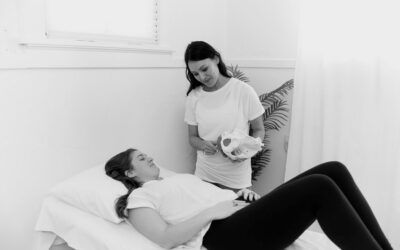If you know us, you know we are huge advocates for pelvic floor physical therapy and women’s healthcare during pregnancy and postpartum. We are also huge advocates for pelvic floor physical therapy for ALL individuals. Why? Because we ALL have a pelvic floor! The anatomy of all our pelvic floors is almost the same.
Everyone Has A Pelvic Floor
If you have a pelvic floor, you are susceptible to pelvic floor dysfunction or injury, regardless of gender or genitals.
That means we are all susceptible to a number of issues that can occur with overactive pelvic floor muscles (painful sex, painful bowel movements, constipation, pelvic pain, etc) or weakened pelvic floor muscles (urinary incontinence, prolapse, etc).
Pelvic floor therapy can be helpful for those that engage in tucking or packing (more on this below), and is extremely important to healing after gender affirmation surgeries. Let’s break it down.
Non-Surgical Gender Affirmation Practices
Pelvic Floor physical therapy can help with a number of side-effects/complications that may accompany nonsurgical gender affirmation practices. Let’s start with some terminology.
-
Binding: Compression of breast tissue for a smaller/flatter chest appearance. Can be done using tight-fitting sports bras, ace bandages, specialty tape, binders, or shirts.
-
Packing: Using a dildo or similar object to create a penis-like bulge in the pants.
-
Tucking: A way to create a flatter appearance in the pelvic region. Typically done with tape or a gaff, the penis is “tucked” under and back to the perineal region and the testicles are tucked up into the inguinal canals. (A gaff is a piece of fabric attached to an elastic band that is worn like underwear and helps the penis remain tucked.)
Binding, tucking, and packing can help someone feel more comfortable in their body, in their clothes, and can ease gender and body dysmorphia. These practices can also come with some complications and painful side effects that physical therapists can help alleviate.
How Pelvic Floor PT Can Help With Binding, Packing, And Tucking
-
Binding can cause back pain, chest pain, poor posture, shoulder pain, numbness, and scarring. We can help reduce pain by working with the muscles and tissues that are affected by constant compression.
-
Packing can lead to changes in walking patterns, muscle tension, pelvic pain, and urinary dysfunction. If using stand-to-pee devices, these devices can cause urinary retention. We can work to relieve tense muscles and work to reduce pelvic pain as well as address urinary concerns.
-
Tucking can lead to pelvic pain, changes in walking patterns, and muscle tension in the legs. It can also lead to urinary dysfunction due to compression of the urethra, as well as an increased risk for developing UTIs. We can work to relieve tense muscles and help to address urinary concerns.
Gender Affirmation Surgeries and Pelvic Floor PT
For those that have had surgery, pelvic floor PT is crucial. Prior to surgery, we can work to improve any underlying issues that may be present that could affect the outcome, and post-op rehab can help muscles and tissues heal. PT will help maximize recovery and achieve full functionality.
-
Top Surgeries – Any type of chest reconstruction can come with challenges. Both augmentation and removal can cause scars and adhesions that may reduce mobility in the chest, ribs, and spine which can affect breathing mechanics, posture, and upper body range of motion.
Physical therapists can help improve scar mobility that can help reduce pain or discomfort and improve range of motion. This can also help reduce scar appearance.
-
Bottom Surgeries – Pelvic floor physical therapy is crucial after any sort of genital reconstruction. These surgeries may result in urinary or bowel dysfunction, such as urgency/frequency, incomplete bladder emptying, or difficulty initiating stream, including painful urination. Pelvic pain or painful sex can also occur after genital reconstruction.
Physical therapists can work with muscles and tissues to help address these issues through a number of techniques. Other post-op considerations that physical therapists can help with include dilation therapy, wound care/scar tissue management, and relearning behaviors with new anatomy.
Healthcare (And Pelvic Floor PT) For All
Our healthcare system in America is seriously lacking. We are on a mission to change that. At NOLA Pelvic Health, we are proud to serve ALL members of our community, including those that identify as LGBTQIA+.
Everyone deserves thorough, caring, and informed healthcare. Our goal is to support and empower patients engaging in nonsurgical gender affirmation practices and gender affirmation surgery.
Additional Resources
We are just one resource for the LGBTQIA+ community (and we’re always here for anyone!). Below, we have rounded up the best list of LGBTQIA resources in New Orleans, Louisiana, and nationwide.
NOLA
Louisiana
Nationwide
_________________________________________________________________________________________________
Interested in more tips on how to prevent or overcome Pelvic Floor Problems?
Download this free guide for some simple, do-able, totally-not-weird tips to take better care of your down there.
_________________________________________________________________________________________________________
Some links may be affiliate links. The products we recommend are products we use or recommend to clients.




